2013.5 Peugeot 308 CC wheel
[x] Cancel search: wheelPage 90 of 268
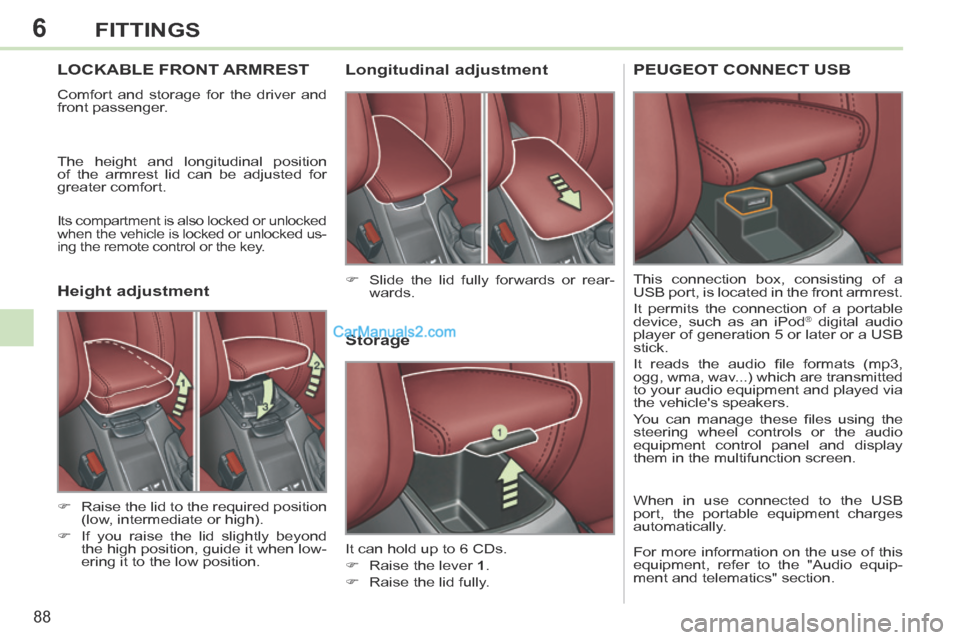
6
88
FITTINGS
LOCKABLE FRONT ARMREST
Comfort and storage for the driver and
front passenger.
The height and longitudinal position
of the armrest lid can be adjusted for
greater comfort.
Its compartment is also locked or unlocked
when the vehicle is locked or unlocked us-
ing the remote control or the key.
Storage
It can hold up to 6 CDs.
Raise the lever 1 .
Raise the lid fully. Slide the lid fully forwards or rear- wards.
Raise the lid to the required position (low, intermediate or high).
If you raise the lid slightly beyond the high position, guide it when low-
ering it to the low position.
Longitudinal adjustment
Height adjustment PEUGEOT CONNECT USB
This connection box, consisting of a
USB port, is located in the front armrest.
It permits the connection of a portable
device, such as an iPod
® digital audio
player of generation 5 or later or a USB
stick.
It reads the audio fi le formats (mp3,
ogg, wma, wav...) which are transmitted
to your audio equipment and played via
the vehicle's speakers.
You can manage these fi les using the
steering wheel controls or the audio
equipment control panel and display
them in the multifunction screen.
When in use connected to the USB
port, the portable equipment charges
automatically.
For more information on the use of this
equipment, refer to the "Audio equip-
ment and telematics" section.
Page 93 of 268
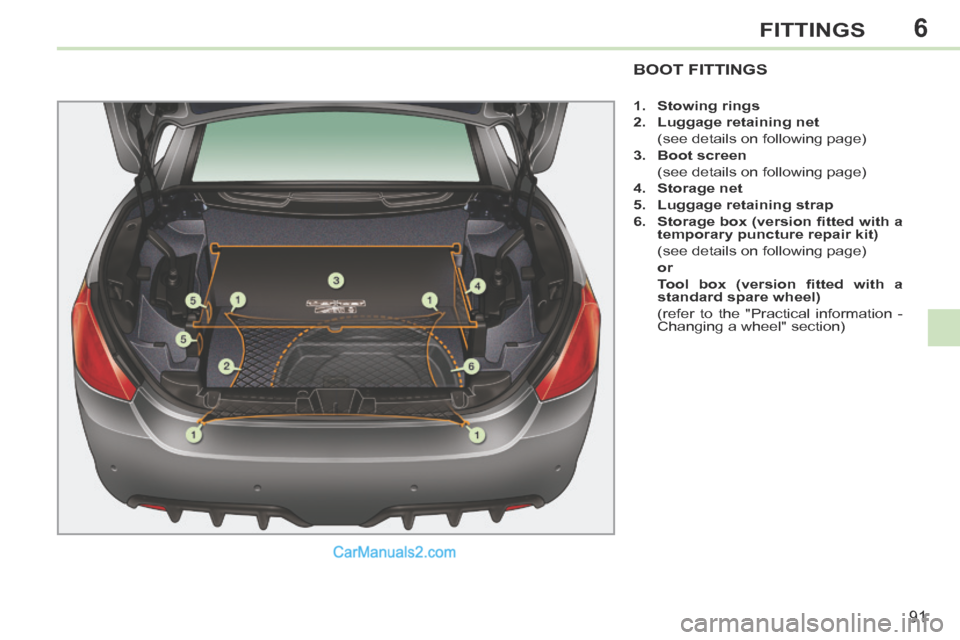
6
91
FITTINGS
BOOT FITTINGS
1. Stowing rings
2. Luggage retaining net
(see details on following page)
3. Boot screen
(see details on following page)
4. Storage net
5. Luggage retaining strap
6. Storage box (version fi tted with a temporary puncture repair kit)
(see details on following page)
or
Tool box (version fi tted with a
standard spare wheel)
(refer to the "Practical information - Changing a wheel" section)
Page 95 of 268
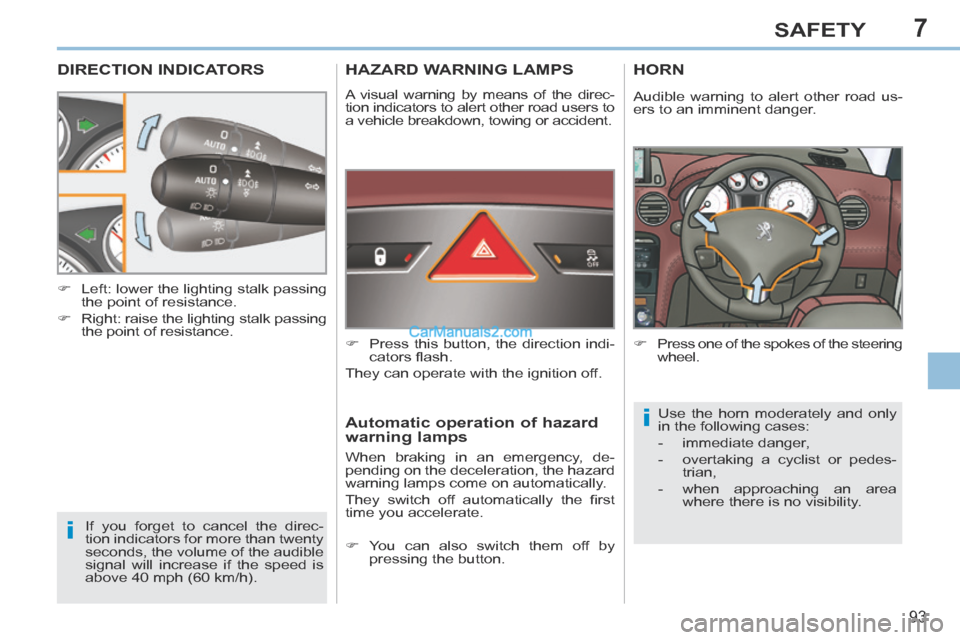
7
i
i
93
SAFETY
DIRECTION INDICATORS
If you forget to cancel the direc-
tion indicators for more than twenty
seconds, the volume of the audible
signal will increase if the speed is
above 40 mph (60 km/h).
Left: lower the lighting stalk passing
the point of resistance.
Right: raise the lighting stalk passing the point of resistance.
HAZARD WARNING LAMPS
A visual warning by means of the direc-
tion indicators to alert other road users to
a vehicle breakdown, towing or accident.
Press this button, the direction indi-cators fl ash.
They can operate with the ignition off.
Automatic operation of hazard
warning lamps
When braking in an emergency, de-
pending on the deceleration, the hazard
warning lamps come on automatically.
They switch off automatically the fi rst
time you accelerate.
You can also switch them off by pressing the button.
HORN
Press one of the spokes of the steering wheel.
Use the horn moderately and only
in the following cases:
- immediate danger,
- overtaking a cyclist or pedes- trian,
- when approaching an area where there is no visibility.
Audible warning to alert other road us-
ers to an imminent danger.
Page 96 of 268
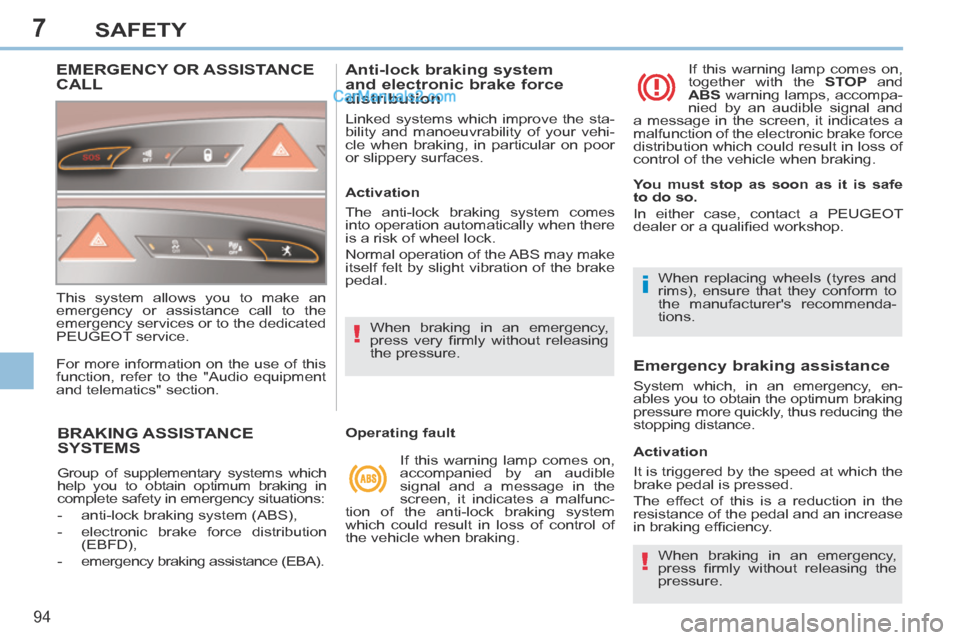
7
!
i
!
94
SAFETY
BRAKING ASSISTANCE SYSTEMS
Group of supplementary systems which
help you to obtain optimum braking in
complete safety in emergency situations:
- anti-lock braking system (ABS),
- electronic brake force distribution (EBFD),
- emergency braking assistance (EBA).
Anti-lock braking system
and electronic brake force
distribution
Linked systems which improve the sta-
bility and manoeuvrability of your vehi-
cle when braking, in particular on poor
or slippery surfaces.
When braking in an emergency,
press very fi rmly without releasing
the pressure. When replacing wheels (tyres and
rims), ensure that they conform to
the manufacturer's recommenda-
tions.
Operating fault If this warning lamp comes on,
accompanied by an audible
signal and a message in the
screen, it indicates a malfunc-
tion of the anti-lock braking system
which could result in loss of control of
the vehicle when braking. If this warning lamp comes on,
together with the
STOP and
ABS warning lamps, accompa-
nied by an audible signal and
a message in the screen, it indicates a
malfunction of the electronic brake force
distribution which could result in loss of
control of the vehicle when braking.
Emergency braking assistance
System which, in an emergency, en-
ables you to obtain the optimum braking
pressure more quickly, thus reducing the
stopping distance.
Activation
The anti-lock braking system comes
into operation automatically when there
is a risk of wheel lock.
Normal operation of the ABS may make
itself felt by slight vibration of the brake
pedal.
Activation
It is triggered by the speed at which the
brake pedal is pressed.
The effect of this is a reduction in the
resistance of the pedal and an increase
in braking effi ciency. When braking in an emergency,
press fi rmly without releasing the
pressure.
You must stop as soon as it is safe
to do so.
In either case, contact a PEUGEOT
dealer or a qualifi ed workshop.
EMERGENCY OR ASSISTANCE CALL
This system allows you to make an
emergency or assistance call to the
emergency services or to the dedicated
PEUGEOT service.
For more information on the use of this
function, refer to the "Audio equipment
and telematics" section.
Page 97 of 268
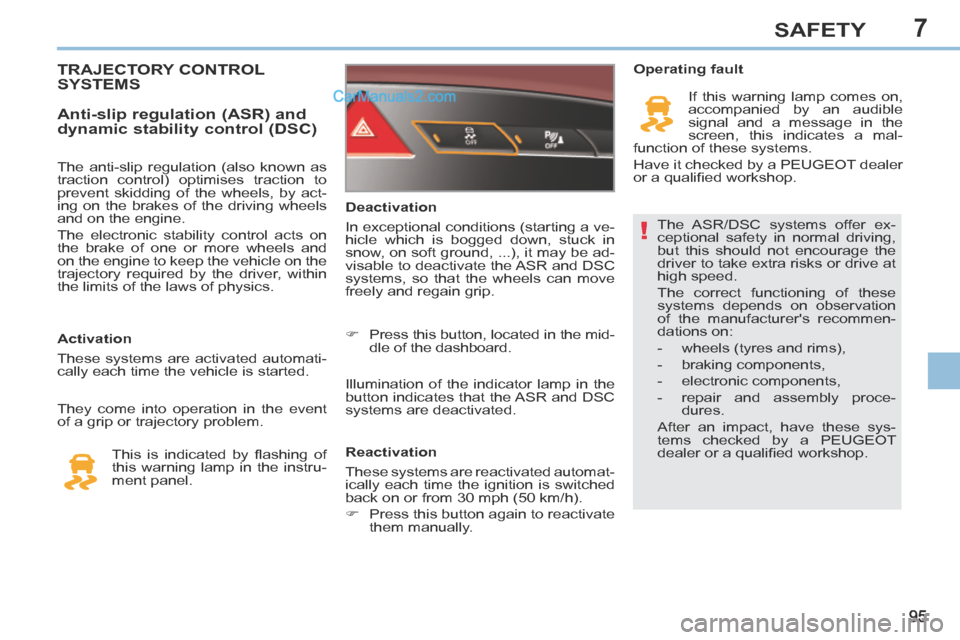
7
!
95
SAFETY
The ASR/DSC systems offer ex-
ceptional safety in normal driving,
but this should not encourage the
driver to take extra risks or drive at
high speed.
The correct functioning of these
systems depends on observation
of the manufacturer's recommen-
dations on:
- wheels (tyres and rims),
- braking components,
- electronic components,
- repair and assembly proce-dures.
After an impact, have these sys-
tems checked by a PEUGEOT
dealer or a qualifi ed workshop.
Deactivation
In exceptional conditions (starting a ve-
hicle which is bogged down, stuck in
snow, on soft ground, ...), it may be ad-
visable to deactivate the ASR and DSC
systems, so that the wheels can move
freely and regain grip.
Press this button, located in the mid- dle of the dashboard.
Illumination of the indicator lamp in the
button indicates that the ASR and DSC
systems are deactivated.
Reactivation
These systems are reactivated automat-
ically each time the ignition is switched
back on or from 30 mph (50 km/h).
Press this button again to reactivate them manually. Operating fault
If this warning lamp comes on,
accompanied by an audible
signal and a message in the
screen, this indicates a mal-
function of these systems.
Have it checked by a PEUGEOT dealer
or a qualifi ed workshop.
TRAJECTORY CONTROL SYSTEMS
Activation
These systems are activated automati-
cally each time the vehicle is started.
Anti-slip regulation (ASR) and
dynamic stability control (DSC)
They come into operation in the event
of a grip or trajectory problem.
This is indicated by fl ashing of
this warning lamp in the instru-
ment panel.
The anti-slip regulation (also known as
traction control) optimises traction to
prevent skidding of the wheels, by act-
ing on the brakes of the driving wheels
and on the engine.
The electronic stability control acts on
the brake of one or more wheels and
on the engine to keep the vehicle on the
trajectory required by the driver, within
the limits of the laws of physics.
Page 102 of 268
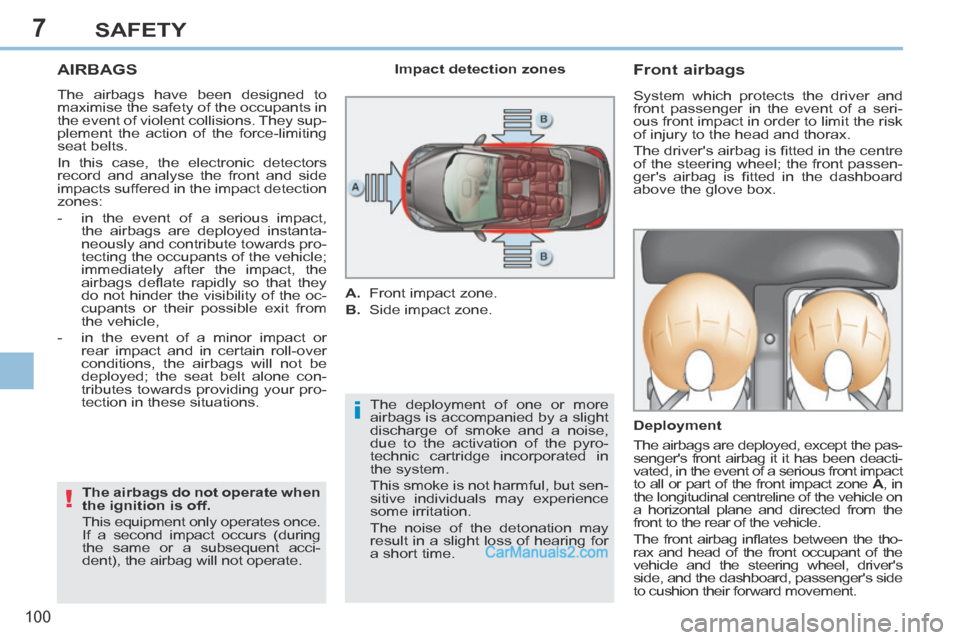
7
i
!
100
SAFETY
AIRBAGS
The airbags have been designed to
maximise the safety of the occupants in
the event of violent collisions. They sup-
plement the action of the force-limiting
seat belts.
In this case, the electronic detectors
record and analyse the front and side
impacts suffered in the impact detection
zones:
- in the event of a serious impact, the airbags are deployed instanta-
neously and contribute towards pro-
tecting the occupants of the vehicle;
immediately after the impact, the
airbags defl ate rapidly so that they
do not hinder the visibility of the oc-
cupants or their possible exit from
the vehicle,
- in the event of a minor impact or rear impact and in certain roll-over
conditions, the airbags will not be
deployed; the seat belt alone con-
tributes towards providing your pro-
tection in these situations. The deployment of one or more
airbags is accompanied by a slight
discharge of smoke and a noise,
due to the activation of the pyro-
technic cartridge incorporated in
the system.
This smoke is not harmful, but sen-
sitive individuals may experience
some irritation.
The noise of the detonation may
result in a slight loss of hearing for
a short time.
Front airbags
Deployment
The airbags are deployed, except the pas-
senger's front airbag it it has been deacti-
vated, in the event of a serious front impact
to all or part of the front impact zone A , in
the longitudinal centreline of the vehicle on
a horizontal plane and directed from the
front to the rear of the vehicle.
The front airbag infl ates between the tho-
rax and head of the front occupant of the
vehicle and the steering wheel, driver's
side, and the dashboard, passenger's side
to cushion their forward movement.
Impact detection zones
A. Front impact zone.
B. Side impact zone.
The airbags do not operate when
the ignition is off.
This equipment only operates once.
If a second impact occurs (during
the same or a subsequent acci-
dent), the airbag will not operate. System which protects the driver and
front passenger in the event of a seri-
ous front impact in order to limit the risk
of injury to the head and thorax.
The driver's airbag is fi tted in the centre
of the steering wheel; the front passen-
ger's airbag is fi tted in the dashboard
above the glove box.
Page 105 of 268
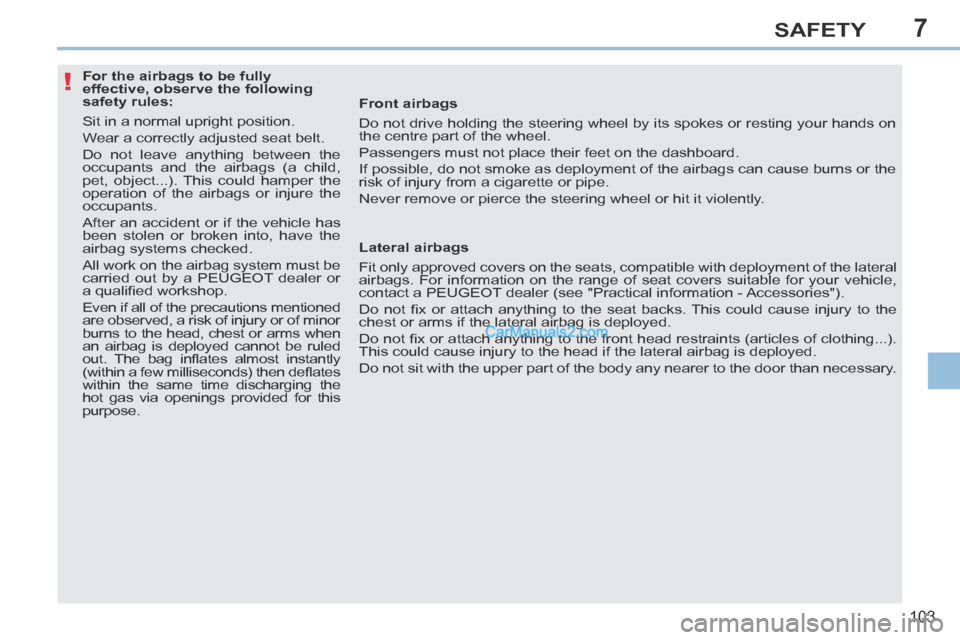
7
!
103
SAFETY
For the airbags to be fully
effective, observe the following
safety rules:
Sit in a normal upright position.
Wear a correctly adjusted seat belt.
Do not leave anything between the
occupants and the airbags (a child,
pet, object...). This could hamper the
operation of the airbags or injure the
occupants.
After an accident or if the vehicle has
been stolen or broken into, have the
airbag systems checked.
All work on the airbag system must be
carried out by a PEUGEOT dealer or
a qualifi ed workshop.
Even if all of the precautions mentioned
are observed, a risk of injury or of minor
burns to the head, chest or arms when
an airbag is deployed cannot be ruled
out. The bag infl ates almost instantly
(within a few milliseconds) then defl ates
within the same time discharging the
hot gas via openings provided for this
purpose. Front airbags
Do not drive holding the steering wheel by its spokes or resting your ha\
nds on
the centre part of the wheel.
Passengers must not place their feet on the dashboard.
If possible, do not smoke as deployment of the airbags can cause burns or the
risk of injury from a cigarette or pipe.
Never remove or pierce the steering wheel or hit it violently.
Lateral airbags
Fit only approved covers on the seats, compatible with deployment of the\
lateral
airbags. For information on the range of seat covers suitable for your vehicle,
contact a PEUGEOT dealer (see "Practical information - Accessories").
Do not fi x or attach anything to the seat backs. This could cause injury to the
chest or arms if the lateral airbag is deployed.
Do not fi x or attach anything to the front head restraints (articles of clothing...).
This could cause injury to the head if the lateral airbag is deployed.
Do not sit with the upper part of the body any nearer to the door than necessary.
Page 116 of 268

8
!
i
!
11 4
DRIVING
When parking on a slope, direct
your wheels against the pavement,
apply the parking brake and en-
gage a gear. PARKING BRAKE
Applying
Pull the parking brake lever fully up to immobilise your vehicle.
When the vehicle is being driv-
en, if this warning lamp and the
STOP warning lamp come on,
accompanied by an audible sig-
nal and a message on the multifunction
screen, this indicates that the parking
brake is still on or has not been properly
released. Releasing
Pull the parking brake lever gently, press the release button then lower
the lever fully.
6-SPEED MANUAL GEARBOX
As a safety precaution and to facili-
tate starting of the engine:
- always select neutral,
- press the clutch pedal.
Only engage reverse gear when
the vehicle is stationary with the
engine at idle.
Engaging reverse gear
Raise the ring under the knob and
move the gear lever to the left then
forwards.
Engaging 5 th or 6 th gear
Move the lever fully to the right to engage 5 th or 6 th gear.